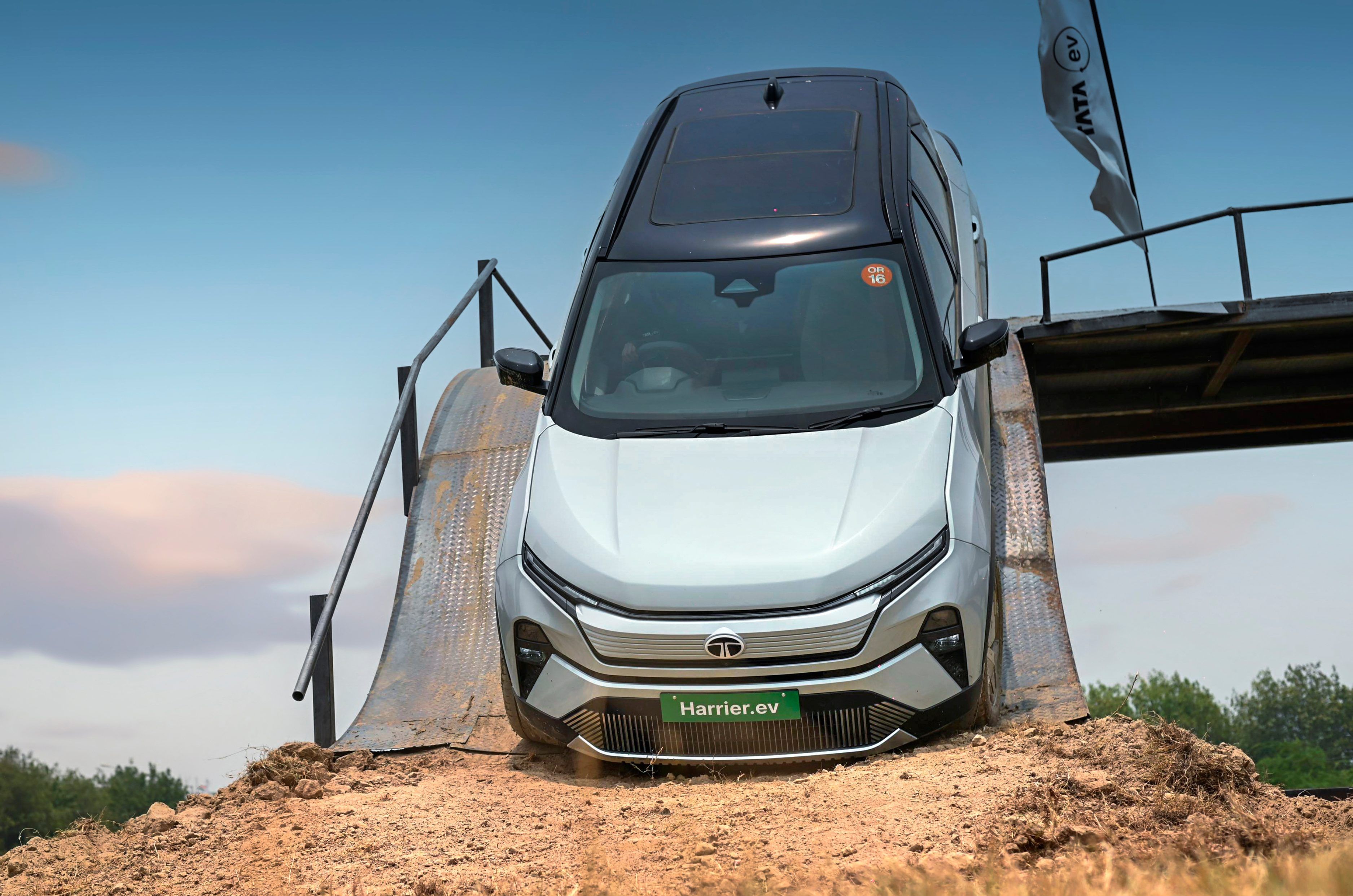
The new Tata Harrier EV can go places where no other Harrier has gone before. And that’s been made possible by 4×4. The range-topping Harrier EV (marketed as dual motor QWD, or quad-wheel drive) features a motor each on the front and rear axles, enabling all-wheel drive. We got a taste of the capabilities this arrangement has unlocked – both off-road and on it – over what Tata Motors dubbed ‘Quad Day’.
A disclaimer first. We had very limited time with the Harrier EV, and the only driving for the day for us was a round on a curated off-road course on the periphery of the Buddh International Circuit. So, you’ll have to wait a bit longer for an in-depth review, which will be possible only when we get the Tata for a full test.
Tata Harrier EV AWD specifications
The hero car today is the range-topping Harrier EV QWD dual motor. To quickly run through the specifications, the QWD features front and rear axle motors. The rear permanent magnet synchronous motor is the main motor and has an output of 238hp. It’s supplemented by a 158hp induction motor up front. Worth highlighting is the fact that combined max power isn’t the sum of the two motor outputs (factors like battery discharge rate impact this) but a still strong 313hp. Max torque is a solid 540Nm. The motors draw power from a 75kWh battery pack.

Real-world range, charging performance, etc., are things we’ll talk about on another day. For now, it’s time to see what the dual motors enable on Tata’s first SUV in a long, long time.
Tata Harrier EV AWD off-road performance and features
First on the agenda was a rocky path, where the Harrier EV’s ‘Off-Road Assist’ function was put to the test. Off-Road Assist works like an off-road cruise control, allowing you to set a speed for the vehicle to maintain – down to 5kph. The feature worked well to keep the momentum going on the carpet of rocks. Another takeaway was ride comfort. The Harrier EV debuts an all-independent suspension with frequency-dependent dampers, and there was less movement inside the cabin than a regular diesel Harrier with a twist beam rear suspension would deliver. This newfound comfort should translate to bad roads and potholes as well.

A bigger challenge up ahead was the ‘bridge’ obstacle. Its 34-degree incline angle was a daunting sight from behind the wheel – something I’m sure would be impossible to clear in a two-wheel-drive SUV. The Harrier EV clawed its way up with grace. I also stopped mid-climb to try the hill-hold assist, and I’m happy to report that the Tata held on gamely. The final ascent after the break looked overwhelming, but the Harrier EV pulled itself up. The descent was smooth, but notably, braking and speed control were manual. We didn’t use hill-descent control on the 35-degree ramp.

Next up was a small sand pit. The Harrier EV gets off-road modes that alter the power balance between front and rear axles, ESC intervention, and more, depending on the selection. Options include Snow/Grass, Mud Ruts, Rock Crawl and Sand, and it’s the last one that I engaged for this obstacle. The shallow sand pit didn’t really challenge the Harrier EV, or maybe the electronics did their job really well.
A see-saw added some showmanship to the entry of what was coined the ‘camel’s hump’. You could think of the obstacle as a visual representation of what the Harrier EV’s 25.3-degree approach, 16.6-degree ramp breakover and 26.4-degree departure angles enable. On my run, the Harrier’s battery did make gentle contact with the ground on the largest hump. Before you ask, Tata Motors hadn’t disclosed the Harrier EV’s ground clearance at the event or time of filing this report, but the figure should be near 200mm (unladen).

What followed was a slush pit – again, an obstacle that would catch your two-wheel-drive SUV out. I didn’t use Off-Road Assist for my run and controlled the accelerator myself. I found the Harrier EV to maintain progress and actually expected it to slide around a lot more. A look at video footage showed the Harrier EV switching power between the front and rear, though you don’t feel it inside the car. Mind you, the Harrier was riding on its standard tyres.

The last obstacle was a climb up a staircase, a scenario I sincerely hope Harrier EV or other off-road users don’t attempt in the real world. The climb was easy enough, but the awkward entry angle to the ramp down and the descent angle itself were a bit unnerving. Again, speed regulation down was done manually via the brake pedal. When levelling out at the base, the Harrier EV’s chin did touch.
All in all, first impressions of the Harrier EV’s off-road ability were very positive. And with the monsoons upon us and flooding a very real scenario that drivers will have to face, it’s handy to know that the Harrier EV can wade through 600mm of water. I can’t wait to see what the Harrier EV can manage on our off-road day.
Tata Harrier EV performance demonstration
The rest of the event was spent as a passenger and spectator. The sight of a Harrier EV towing a 24-tonne army 8×8 and a quartet of Harrier EVs pulling off a synchronised J-turn sure made for cool viewing.

It was also quite exciting to experience the Harrier EV’s acceleration. Tata claims a 6.3 second 0-100kph time, which makes the Harrier EV the quickest made-in-India car! Our pilot also took the Harrier EV to 160kph on BIC’s back straight, and it could have gone faster still. Handling seemed well-sorted, too, though, again, I’ll reserve judgement till I’m the one behind the wheel.
Tata Harrier EV ADAS and tech demonstration
We also witnessed some of the Harrier EV’s ADAS functions, like emergency braking and Intelligent Speed Assist, in action. Intelligent Speed Assist reads speed signs and prompts the driver to drop speed accordingly, a clever preventive measure against hefty speeding fines.

Auto parking that detects a parking spot and takes over the accelerator, brake and steering duties did well on its test run. What’s nice is the option to manually select a parking slot, which is helpful when the parking is not well-marked. The parking features can also be used from outside the car, which is handy for times when access to your slot is tricky, say, with a large puddle outside the door.
A related function is Reverse Assist. It’ll memorise the last 50m of your path and can automatically reverse out without the need for any intervention at the steering or pedals. Tata Motors replicated a market environment to simulate this, and it did work well, but a real-world test with all the chaos around would be needed to judge it properly.

A feature that’s got a lot of people talking is the Harrier EV’s ‘Digital Mirror’. At the press of a switch, the inside mirror acts as a screen and relays feed from a roof-mounted camera. The feed was good and lag-free, though performance at night and in the rain remains to be seen. On the subject of cameras, the ‘Transparent Bonnet’ that stitches front camera inputs to create an image from under the bonnet is handy, particularly off-road. We did notice lag from the blind-view cameras whose feed comes on the touchscreen, though.
Tata Harrier AWD price and rivals
Tata Motors has so far only announced the price for the entry-level Harrier EV with a single rear motor and smaller 65kWh battery pack, which costs Rs 21.49 lakh (ex-showroom). Pricing for the rest of the range will be released over the coming few weeks. We expect this fully loaded Harrier EV dual-motor QWD to be priced upwards of Rs 30 lakh.
How the Harrier EV performs in the real world and fares against rivals, like the Mahindra XEV 9e, is something we’re itching to know. But it does have something rivals don’t have – all-wheel drive. The event day experience suggests the hardware gives the Harrier EV off-road capability to back the bragging rights.
Also See:

